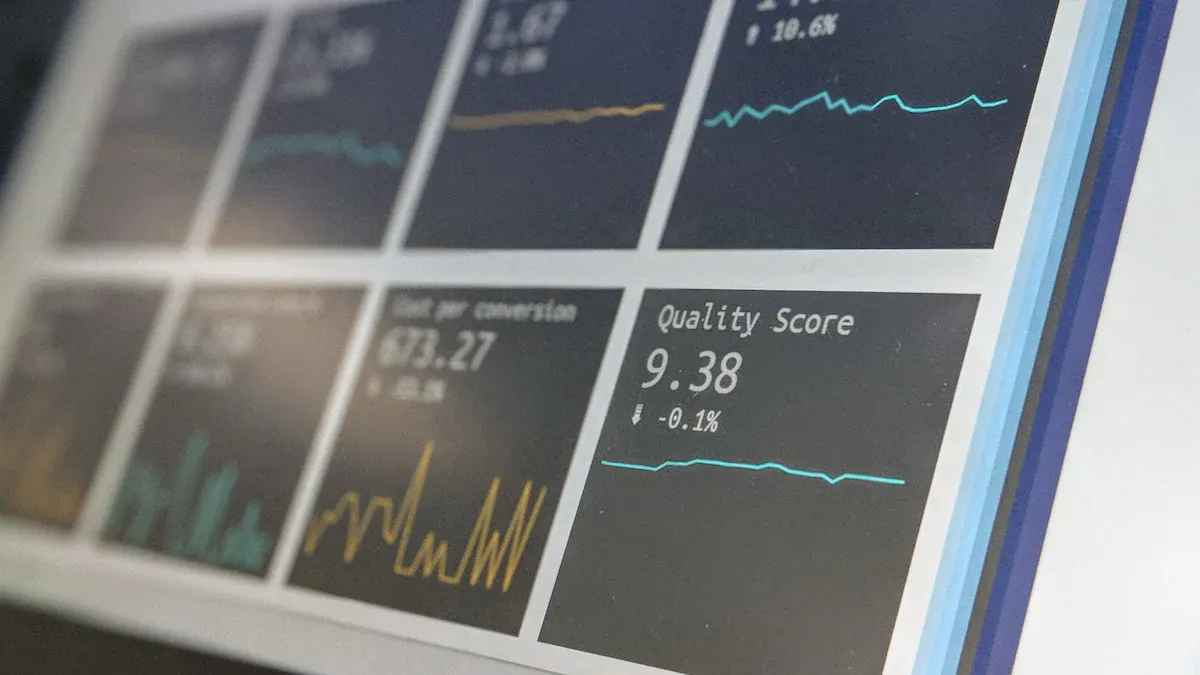Real-Time Blog Monitoring with AI

AI transforms how you monitor blogs. With real-time blog monitoring, you see what your audience says about your brand the moment it happens. You get instant insights and can react before issues grow. AI tools analyze social conversations, process feedback, and provide actionable insights in seconds. Companies using real-time monitoring experience up to 21% higher revenue growth and respond to market changes five times faster than competitors. Social listening with AI lets you understand trends, protect your reputation, and connect with your audience in new ways.
Key Takeaways
AI-powered real-time blog monitoring helps you see audience feedback instantly and respond faster than traditional methods.
Manual tracking wastes time and causes errors, while traditional tools often lack speed and scalability.
AI tools automate tracking, analyze sentiment, and filter out irrelevant content to deliver accurate and useful insights.
Choosing the right AI tool and setting up smart alerts and filters lets you focus on important changes and save time.
Integrating AI monitoring into your daily workflow boosts productivity and helps your team make better decisions quickly.
Real-Time Blog Monitoring Challenges

Manual Limitations
When you try to monitor blogs by hand, you face many problems. Manual tracking takes a lot of time and energy. You might miss important updates or fail to spot changes as they happen. If you use spreadsheets or handwritten notes, you increase the risk of mistakes. Many people find that manual methods lead to errors like copying the wrong information or entering data twice. These mistakes can cause you to lose track of key blog posts or miss sudden changes in online conversations.
Manual evidence tracking in other fields, like law enforcement, shows similar issues:
Handwritten logs and spreadsheets are labor-intensive and error-prone.
One agency cut intake time by 75% after switching to automated systems.
Documentation errors dropped by 90% with automation.
Lost evidence incidents fell by 50% when using automated tracking.
Manual blog monitoring often leads to wasted hours and missed opportunities. A survey of compliance professionals found that automation reduced their monthly workload by 97%. Most users cut their time spent on tracking by at least half. If you want to track web changes quickly and accurately, manual methods will slow you down.
Traditional Tools
Traditional web monitoring tools also have limits. Many of these tools do not offer real-time blog monitoring. You may need to wait for scheduled updates or refreshes, which means you can miss fast changes. These tools often require you to pay extra for more features or to add new data sources. If you want to scale up your monitoring, you might need to buy more licenses or hardware.
Common problems with traditional monitoring tools include:
Limited or paywalled integrations that slow down your workflow.
Vendor support is often needed for custom automation.
Scalability is restricted by licensing and infrastructure limits.
Adding new endpoints or sources can be slow and costly.
Modern web monitoring needs to keep up with rapid changes. Traditional tools lack the automation and instant response you need to monitor blogs effectively. You risk missing important trends or failing to respond to issues before they grow.
AI Benefits
Automated Tracking
AI changes how you monitor blogs and social conversations. You no longer need to check each site by hand. AI-powered systems use machine learning and natural language processing to scan thousands of sources in seconds. These tools track new posts, comments, and mentions as soon as they appear. You get real-time blog monitoring that keeps you ahead of the curve.
AI tracking systems use smart algorithms to monitor and evaluate data from many sources.
You receive instant alerts when something important happens.
AI-generated summary features help you understand what matters most without reading every post.
Companies using AI for remote performance tracking have seen a 30% increase in productivity.
A multinational corporation used an AI performance engine and boosted employee productivity by 40%.
Machine learning performance metrics, such as regression and classification scores, help you see how well your monitoring works. Tools like Neptune.ai let you track and debug AI models at scale. These metrics give you detailed insights into how your AI system performs. You can customize your monitoring to fit your needs and scale up as your audience grows. Smart productivity metrics use behavioral analytics and context to improve traditional web monitoring.
Sentiment & Trend Analysis
AI does more than just track posts. It helps you understand how your audience feels and what topics are gaining attention. Sentiment analysis uses AI and natural language processing to read the emotional tone of blog content in real time. You can spot positive, negative, or neutral reactions as soon as they happen. This helps you adjust your strategy quickly.
Tip: Real-time sentiment analysis lets you respond to customer feedback before it becomes a bigger issue.
Evidence Type | Description |
|---|---|
Accuracy Improvement | Hybrid sentiment analysis systems reach up to 91% accuracy, beating single-method systems by 17%. |
Multi-Channel Data Benefits | Multi-channel analysis finds 2.8 times more actionable insights than single-channel methods. |
Real-Time Application Impact | Companies using real-time sentiment dashboards cut negative user sentiment by 34% in six months. |
Case Studies | Microsoft improved user satisfaction by 24% using sentiment analysis; Adobe saw a 40% rise in positive sentiment after using sentiment data for redesigns. |
ROI and Business Impact | Sentiment analysis gives an average ROI of 287% over three years, with lower support costs and faster issue detection. |
Domain-Specific Models | NLP models trained on specific topics improve sentiment accuracy by 37%. |
AI-generated summary tools highlight the most important trends and topics. You can use these insights to guide your content, improve your products, or connect better with your audience. Real-time blog monitoring with AI helps you spot trends before your competitors do. Social analytics dashboards show you what people care about right now.
Noise Filtering
Not every blog post or comment matters. AI helps you filter out the noise so you only see what is relevant. Noise filtering algorithms remove irrelevant, misleading, or duplicate information. This step improves the accuracy of your monitoring and saves you time.
Manual filtering takes too long and leads to mistakes.
Automated filtering uses smart rules to sort data quickly and reduce errors.
Dynamic filtering adapts to your needs in real time, making sure you see the most relevant content.
Statistical filtering finds patterns and trends, helping you focus on what matters.
Studies show that noise in text data can lower model accuracy by up to 8.2%. Nearly 27% of data quality problems in machine learning come from noisy data. Dr. Tom Mitchell, an expert in AI, says that models trained on noisy data can make wrong or even harmful decisions. By using AI to clean your data, you improve the quality of your insights and make better choices.
AI-powered noise filtering also reduces processing costs. You do not waste resources on useless data. You get faster, more accurate alerts and can respond to real issues right away. This makes your real-time blog monitoring more effective and helps you stay ahead in web monitoring and social analytics.
Note: Effective noise filtering means you only monitor what matters, so you can focus on real insights and trends.
Setup Guide
Tool Selection
Choosing the right AI tool for real-time blog monitoring helps you stay ahead of changes and trends. You want a solution that fits your needs and grows with your business. Start by thinking about what you want to track and how fast you need to react. Some tools focus on speed, while others offer deep analysis or easy setup.
Here is a table to help you compare important criteria when picking AI website monitoring tools:
Criteria / Consideration | Description / Metrics |
|---|---|
Purpose of Monitoring | Look at system speed, data quality, and how well the tool tracks changes and outliers. |
Platform-Agnosticism | Make sure the tool works on different cloud platforms and fits with your current systems. |
Tool Maturity Level | Choose tools that have proven reliability and strong user communities. |
Level of Product Support | Check for good support, clear guides, and active user groups. |
Ease of Use | Pick tools that let you set up dashboards, custom metrics, and alerts without much effort. |
Production-Grade Scalability | The tool should handle lots of data and many users without slowing down. |
Open-Source vs Commercial Trade-offs | Open-source tools cost less and offer more control, but may lack support. Commercial tools cost more but give better features and help. |
When you select a tool, gather high-quality data and make sure it matches your needs. Pick models that balance speed and accuracy. Design your setup so you can add more data or users as your needs grow. Cloud-based solutions like Azure, GCP, or AWS help you scale up quickly. Work with your team to set clear rules for monitoring and keep checking your tool’s performance.
Tip: Always test your tool with real blog data before you go live. This helps you spot problems early and make better choices.
Alerts & Filters
Setting up alerts and filters lets you focus on what matters most. AI tools can send you alerts when they detect important changes or trends. You can choose to get alerts for new blog posts, sudden spikes in mentions, or shifts in sentiment. This way, you never miss a key update.
To avoid information overload, use filters to sort out noise. AI-powered summarizer features help you see the main points without reading every post. You can set filters for topics, keywords, or even the tone of the conversation. This makes it easier to track web changes that matter to your business.
Set up alerts for:
New blog mentions of your brand or products
Sudden changes in sentiment or trending topics
Unusual spikes in blog activity
Use filters to:
Remove duplicate or irrelevant posts
Focus on specific topics or authors
Highlight urgent issues that need fast action
Note: Smart alerts and filters save you time and help you respond faster to important changes.
Workflow Integration
Integrating AI blog monitoring into your daily workflow boosts your team’s productivity. You can connect your monitoring tool with other business systems, like email, chat, or project management apps. This way, you get alerts where you work and can act quickly.
Many companies see big gains after adding AI to their workflows. For example, manufacturers who use AI-powered monitoring cut downtime by 37% and save millions each year. Financial firms reduce errors and speed up processes by over 60%. Retailers like Zara use AI to track supply chain changes, cutting lead times from weeks to days. These results show that AI website monitoring tools can make your business more efficient and responsive.
According to research, companies that use AI-driven workflow optimization improve productivity by up to 35%. They also see a faster return on investment, often within a year. AI helps you collect data, find weak spots, and test new ideas before making big changes. This leads to better decisions and smoother operations.
To get started, follow these steps:
Map out your current workflow and find where you need faster updates.
Connect your AI monitoring tool to your main business apps.
Set up custom alerts for your team.
Train your team to use the new system and review results often.
Adjust your filters and alerts as your needs change.
Callout: Regularly review your workflow and update your monitoring setup. This keeps your system effective as your business grows.
AI Social Listening

AI social listening gives you the power to monitor blog mentions and discussions as soon as they happen. With social listening tools, you can track every change in your brand’s online presence. These tools scan blogs, forums, and social media for new posts, comments, and trends. You get instant alerts when your audience talks about your brand or products. AI social listening helps you understand what people say, how they feel, and what topics matter most. You can use these insights to improve your strategy and connect with your audience in real time.
Brand Monitoring
You need to know what your audience thinks about your brand. AI social listening tools help you monitor blogs and social channels for every mention. These tools use AI to analyze the tone of each post, so you can spot positive or negative feedback right away. Social listening tools let you respond quickly to changes in sentiment. You can protect your reputation and build trust with your audience. Media monitoring tools also help you track how your brand compares to others in your industry. You see which topics drive the most engagement and which changes affect your brand image.
Tip: Set up alerts in your social listening tools to catch sudden changes in blog discussions about your brand.
Competitive Intelligence
AI social listening tools help you monitor your competitors’ blogs and social channels. You can track how often they publish, what topics they cover, and how their audience reacts. Social listening tools show you which keywords and trends your competitors use. You can see their new products, marketing campaigns, and changes in strategy. AI platforms like Magai let you filter content by topic, engagement, and timing. You get real-time analytics and automated reports, so your team can act fast.
Companies using AI for competitive analysis grow about 20% faster than others.
AI social listening tools help you spot gaps in the market and respond to competitor changes quickly.
A global IT company saved 12 hours each week by using AI to monitor competitor blogs.
A California bank increased qualified leads by 20% with AI-driven competitive intelligence.
Social listening tools make it easy to set up rules for monitoring. You choose data sources, update frequency, and keywords. AI-generated reports highlight patterns and trends, helping you make smart decisions.
Risk Detection
AI social listening tools help you detect risks before they become big problems. These tools use data analytics to find patterns and trends in blog posts and social media. You can see which risks are high, medium, or low, so you know where to focus. Predictive models use machine learning to suggest ways to reduce risks. Social listening tools give you real-time access to data and clear visualizations, making it easy to act fast.
AI social listening tools use predictive analytics to spot compliance issues early.
Quantitative risk models measure the chance and impact of each risk, using real-time data from blogs and social channels.
AI-driven systems lower false alarms by learning from past data, saving you time and resources.
You can connect AI social listening tools with your current compliance systems for continuous monitoring.
Companies see up to 30% better risk detection with AI compared to old methods.
Note: Regular use of social listening tools helps you stay ahead of risks and keep your business safe.
You gain a real advantage with real-time blog monitoring powered by AI. You see insights as they happen, not days later. AI analytics collects, processes, and analyzes data instantly, giving you actionable insights for every social mention. You spot trends, track social conversations, and respond faster than ever.
Traditional methods miss key insights and slow your response.
AI-driven social monitoring improves accuracy and delivers insights you can use right away.
Social listening tools help you protect your brand and make smarter decisions.
Start by exploring AI social tools that fit your needs. You will see how fast, accurate insights transform your social strategy.
FAQ
What is real-time blog monitoring with AI?
You use AI to track blogs as soon as new content appears. AI scans posts, comments, and mentions. You get instant alerts and insights. This helps you react quickly to trends or issues.
How do AI tools differ from traditional social media monitoring tools?
AI tools work faster and give you real-time updates. You see trends and risks as they happen. Traditional social media monitoring tools often update slowly and miss sudden changes.
Can AI-powered blog monitoring improve social media analytics?
Yes. AI-powered blog monitoring gives you more data and better insights. You see patterns and trends across blogs and social channels. This improves your social media analytics and helps you make smarter decisions.
Is it easy to set up AI blog monitoring for my business?
You can set up most AI blog monitoring tools quickly. Many offer simple dashboards and guides. You choose what to track and set alerts. Most tools work with your current systems.
How does AI help filter out irrelevant blog content?
AI uses smart filters to remove spam, duplicates, or off-topic posts. You only see important updates. This saves you time and helps you focus on what matters most.
See Also
Transforming Blogging With AI Tools That Redefine Success
Comprehensive AI Blog Builders Cover Hosting Writing SEO
Top Blogging Platforms Trending For Beginners In 2024
Beginner’s Guide To Starting A Successful Blog Today
Four Essential Blogging Tips For Beginners From Past Lessons

